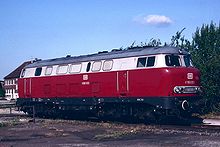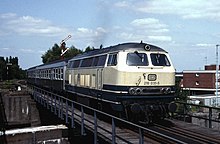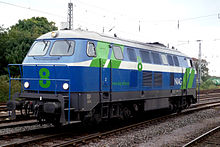DB class V 160
| DB class V 160 DB class 216 |
|
|---|---|
|
216 221 on July 8, 1997 in Grossenlüder
|
|
| Numbering: | V 160 001–154 from 1968 216 001–224 |
| Number: | 224 |
| Manufacturer: | Krupp , KHD , Henschel , Krauss-Maffei , MaK |
| Year of construction (s): | Pre-series 1960 series 1964–1968 |
| Retirement: | Pre-series 1978–1984 series 1993–2004 |
| Axis formula : | B'B ' |
| Gauge : | 1435 mm ( standard gauge ) |
| Length over buffers: | 16,000 mm |
| Height: | 4,250 mm |
| Width: | 3,040 mm |
| Trunnion Distance: | 8,600 mm |
| Bogie axle base: | 2,800 mm |
| Total wheelbase: | 11,400 mm |
| Empty mass: | 68.9 t |
| Service mass: | 76.7 t |
| Wheel set mass : | 19.2 t |
| Top speed: | High speed: 120 km / h Slow speed: 80 km / h |
| Installed capacity: | 1,400 kW |
| Starting tractive effort: | 240/170 kN |
| Driving wheel diameter: | 1,000 mm |
| Motor type: | 1 × MTU MB 16 V 652 TB 10 or MTU MD16 V 538 TB 10 * |
| Rated speed: | 1500 rpm |
| Power transmission: | hydraulic |
| Tank capacity: | 2,700 l |
| Brake: | KE-GPP²mZ compressed air brake |
| Train heating: | steam |
| * Pre-series | |
The class V 160 (from 1968: class 216 ) was a diesel locomotive type of the Deutsche Bundesbahn . This is the first variant of the V 160 family, which was planned as a single-engine large diesel locomotive for medium-heavy line service in the Bundesbahn's post-war new build program .
history

In the 1950s, the capacity of the available railroad diesel engines increased from 993 kW (1350 hp) to approx. 1400 kW (approx. 1900 hp) and more. Now nothing stood in the way of the development of a single-engine, medium-heavy mainline diesel locomotive until it was ready for series production. The specification was a maximum speed of 120 km / h and the installation of a steam heater . Diesel locomotives did not yet have any technology for the electrical heating of passenger trains. This is how development at Krupp began in the spring of 1956 . The V 160 001 was the first of a total of ten pre-series machines to be delivered in July 1960, six were manufactured by Krupp and another four by Henschel. The first nine pre-series machines have an even more rounded vehicle head, which earned them the nickname "Lollo" (in reference to Gina Lollobrigida ), while from the tenth machine the smooth-surfaced vehicle head designed by Klaus Flesche at Henschel for the V 320 001 was used there it was significantly cheaper to produce and proved to be more streamlined. With the exception of the V 160 006, the pre-series machines were initially equipped with Maybach MD 16 V 538 TB engines.
The series delivery of the machines V 160 011 to 224 took place in five series from 1964 to 1968. Manufacturers were Krupp , Henschel , KHD , Krauss-Maffei and MaK . From number 155 onwards, the machines already bore the series designation 216 when they were delivered. The other machines have been re-designated.
As a result of the primary development of more powerful and faster diesel locomotives with electric heating, a whole family of vehicles with over 800 units has emerged over the years from the V 160, which arose from various variants of the train heating supply and the testing of gas turbines . In the DB series scheme introduced in 1968 , the different variants are listed as 210 , 215 , 216, 217 , 218 and 219 . Deutsche Bahn later created the 225 and 226 series through redrawings (conversions) . With the delivery of the 218 series, the field of application of the 216 series was increasingly concentrated on freight transport because of the steam heating; from 1990 there were no more local transport vehicles that were still heated with steam. From 2000 to 2004 the stock of 216s was thinned out so that in 2004 the last machine was taken out of service.
The pre-series machines were retired from 1978 to 1984.
From 1993 the series machines were also taken out of service to a greater extent. At the beginning of February 2004 the last five machines were also shut down.
technology
The locomotive is powered by the MTU 16 V 538/652 TB 10 diesel engine with 16 cylinders and an output of 1397 kW (1900 hp) at 1500 rpm. The power reaches the final drives in the two two-axle bogies via a hydraulic transmission from Voith with two converters and a clutch and cardan shafts . In the series version, the motor is elastically mounted in a closed motor chamber, which leads to lower noise emissions. In addition to the diesel engine, there is a small auxiliary diesel engine that can be used when upgrading - especially to operate the steam boiler - and as a compressor for air supply. But there is also an electric air compressor. A steam heating device Vapor-Heating OK4616 from Hagenuk was installed for the passenger train service , which can also preheat the machinery and keep it warm.
Numerous machines have conventional push-pull train and double traction control via the 36-pin control cable. In their last years of operation, many machines were retrofitted with door blocking from 0 km / h ( TB0 ) and the EBuLa computer.
The safety driving circuit and punctual train control are also available on safety devices . The latter was upgraded to the functionality of the PZB 90 by installing a computer core . The train radio was only installed later . There are also whistling facilities and sand spreading facilities.
With the self-supporting vehicle body, a base frame welded from sheet metal supports the body made of hollow profiles with sheet metal covering. The engine room is located between the two front driver's cabs. It had a side aisle, while the later series of the V 160 family had two side aisles. The welded bogies consist of box sections, they are connected to the frame via pivot pins. The wheel sets have roller bearings and are cushioned with leaf springs or metal rubber springs in the bogie.
Color schemes
The 216 series - at that time still referred to as the V 160 - was delivered in the classic purple-red paintwork with a black fan band, whereby the pre-series in the area of the windows and ventilation grilles was still provided with a continuous beige band until 1967. The museum locomotive 216 221 still has the purple paint.
In January 1975, the first machine, 216 071, was painted in the new ocean blue-beige color scheme.
216 068 was the first locomotive of this series to receive the orient red paint with a white "bib" on the end faces in February 1988, which faded out faster than average and blurred the contours of the machine.
A repainting to the color scheme introduced in 1997 in traffic red with a contrasting gray frame was no longer planned for the 216 series, but eight machines were still given this paintwork from November 2000: 216 188 as the first copy, followed by 216 094, 102, 136, 139 , 143, 165, 188.
Whereabouts
Several locomotives were sold to private railways in Germany and abroad (including Italy and France), where they are still in use today. Almost all of the other 216 that did not find a new home outside of the DB have now been scrapped.
The pre-series machine V 160 003 - belongs to the DB AG and is looked after by the association "Historical Railway Vehicles Lübeck" (HEL eV). This will be preserved there for posterity. For financial reasons, a due general inspection cannot be carried out. 216 067 is in the DB Museum Koblenz and has been painted in old red since May 2011. 216 221 was initially deposited with the Rendsburg Railway Friends, since 2015 the locomotive has been on permanent loan from the DB Museum to the Upper Hessian Railway Friends in Giessen.
The V 160 001 (now 1900.008) and the V 160 006 (now 1900.007) had been in use at the Italian Azienda Consorziale Trasporti di Reggio Emilia (ACT) since 1982 and went to the Ferrovie Emilia Romagna (FER) regional train on January 1, 2009 . There the V 160 001 received a refurbishment with a repaint in the colors of the delivery (purple-red).
The V 160 002 was bought and refurbished by a private person after it was parked in Spain, it has been operational again since September 2015.
216 224 is employed by the International Society for Rail Traffic (IGE).
DH 1504

The first conversion locomotive of the DH 1504 series was presented in 1998 by On Rail. The concept envisaged creating a new mainline locomotive of medium performance from a few existing former state railroad copies of the class 216. For this, an almost completely new locomotive was built, which only had the gearbox, the bogies and the locomotive shell in common with the donor locomotive. The DH 1504 are powered by 1500 kW MTU engines. A total of six of these locomotives were built, three locomotives are currently in use at OHE , two at NIAG and one at mkb . It is questionable whether further modifications will be made, as there are hardly any suitable donor locomotives available.
Series 226
In 2003, vehicles of the 216 series that were no longer required in the route service were converted for use by DB Reise & Touristik as an ICE 3 auxiliary locomotive. For this purpose, the steam generators for the train heating at the DB plant in Bremen were replaced by Webasto parking heaters and corresponding counterweights. In addition, a Scharfenberg coupling was installed. The 216 096, 130, 131, 135, 146, 154 and 156 were converted, whereby the 216 096 only served as a spare part dispenser and was not redrawn.
The last six machines in the 216 series were redesignated as the 226 series. Two machines each were stationed at the Montabaur and Siegburg / Bonn stations on the Cologne – Rhine / Main high-speed line .
For this purpose, more powerful locomotives of the technically similar DB class 218 were available from 2004 . These were given the designation 218.8 and replaced the class 226 locomotives, which were scrapped by 2005.
Narrow gauge V-160
In the years 1964–1966, the Henschel company built five 1000 mm narrow-gauge locomotives which, at least outwardly, are very similar to the V 160 series. They were delivered to the Ferrocarril Minero de Sierra Menera in Spain and, after they were discontinued, sold to the state narrow-gauge railway company FEVE . One of these locomotives (formerly FEVE 1405) has been in working order on the Brohltalbahn as D5 since 1998 (as of May 2015).
Web links
- The V160 family
- V160 003 at "Historical Railway Vehicles Lübeck eV"
- "Schmalspur-V 160" of the Brohltalbahn
Individual evidence
- ^ V 160 003 at "Historische Eisenbahnfahrzeuge Lübeck eV"
- ↑ Andreas Ritzl: 216221 - diesel locomotive. Retrieved March 7, 2017 .
- ↑ Eisenbahn-Magazin 10/2009, p. 20
- ↑ Florian Dürr: Fresh cell treatment for a diesel veteran . In: Eisenbahn Magazin . No. 11 , 2015, p. 36-37 .
- ↑ Message series 226 . In: Eisenbahn-Revue International , issue 10/2003, p. 435.





